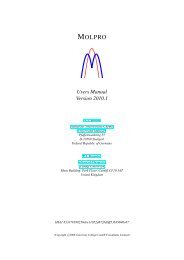Carbon−Carbon Coupling Reactions Catalyzed by Heterogeneous ...
Carbon−Carbon Coupling Reactions Catalyzed by Heterogeneous ...
Carbon−Carbon Coupling Reactions Catalyzed by Heterogeneous ...
Create successful ePaper yourself
Turn your PDF publications into a flip-book with our unique Google optimized e-Paper software.
<strong>Heterogeneous</strong> Pd <strong>Catalyzed</strong> C−C <strong>Coupling</strong> <strong>Reactions</strong> Chemical Reviews, 2007, Vol. 107, No. 1 159<br />
Table 59. [Pd(NH3)4] 2+ /NH4Y-<strong>Catalyzed</strong> Copper-Free<br />
Sonogashira <strong>Reactions</strong><br />
ArX R<br />
[Pd(NH3)4] 2+ /<br />
NH4Y<br />
yield a (%)<br />
Ph-I Ph 100<br />
4-MePh-I Ph 100 (82)<br />
4-AcPh-I Ph 100 (85)<br />
2-NO2Ph-I Ph 100 (89)<br />
2-MePh-I Ph 82 (67)<br />
Ph-I CtC-<br />
CH2O-<br />
TMS<br />
4.4. Pd on Modified Silica<br />
[Pd(NH3)4] 2+ /<br />
NaY<br />
yield b (%)<br />
[Pd]SBA-15<br />
yield b (%)<br />
80 (57)<br />
Ph-Br Ph 45c 73<br />
4-MePh-Br Ph 30<br />
4-AcPh-Br Ph 100<br />
2-Naphthyl-Br Ph 0 100 (99)<br />
10-Anthryl-Br Ph 0 100 (76)<br />
2H-pyran-2-one-<br />
4-yl-tosylate<br />
Ph 100 (95) 100<br />
a GC yields; isolated yields in parentheses. b Conversion; isolated<br />
yields in parentheses. c Yield 85% (GC) with [Pd(PPh3)2]Cl2, 73% (GC)<br />
with [Pd]SBA-15, 20% (GC) with [Pd(II)]/NaY, and 3% (GC) with<br />
Pd(0)/C.<br />
The catalyst obtained <strong>by</strong> encapsulation of palladium<br />
nanoparticles in a silica matrix (SiO2/TEG/Pd) showed high<br />
catalytic activity in the Sonogashira coupling of methyl<br />
4-iodobenzoate with phenylacetylene (Scheme 42). 120 Phosphines<br />
as ligands were not necessary. Another type of Pd<br />
catalyst on silica was obtained when 3-aminopropyl-modified<br />
silica gel was functionalized with phosphine ligands and<br />
transformed into a stable immobilized palladium complex<br />
(Scheme 36). This catalyst was successfully applied in a<br />
series of fast, copper-free Sonogashira coupling reactions<br />
(Scheme 43). 192<br />
Scheme 42. SiO2/TEG/Pd-<strong>Catalyzed</strong> Sonogashira Reaction<br />
Scheme 43. Modified Silica Supported Palladium <strong>Catalyzed</strong><br />
Copper-Free Sonogashira <strong>Coupling</strong><br />
4.5. Pd on Clay and Other Inorganic Materials<br />
Layered double hydroxide supported palladium nanoparticles<br />
(LDH-Pd(0)) allowed Sonogashira coupling of chloroarenes<br />
to be carried out under Cu-free conditions (THF/<br />
water, NEt3) and provided high activity (Table 60) 66 Even<br />
electron-rich chloroarenes could be coupled in this way<br />
(Table 60, entry 2). The catalyst (1 mol %) was used in five<br />
cycles and showed consistent activity in the coupling of<br />
phenylacetylene and chlorobenzene. Nonaqueous ionic liquids<br />
(NAIL) could also be used for this catalytic system<br />
(Table 60, entry 1).<br />
Table 60. LDH-Pd(0)-<strong>Catalyzed</strong> Sonogashira Reaction of<br />
Chloroarenes with Phenylacetylene<br />
a Under NAIL conditions.<br />
5. Stille, Fukuyama, and Negishi <strong>Reactions</strong><br />
5.1. Stille <strong>Reactions</strong><br />
5.1.1. Pd on Carbon (Pd/C)<br />
Liebeskind and co-workers193,194 reported Pd/C-catalyzed<br />
Stille cross-coupling reactions. The protocol was optimized<br />
<strong>by</strong> the addition of CuI as cocatalyst and the ligand AsPh3<br />
[Pd/C (0.5 mol %), CuI (10 mol %), AsPh3 (20 mol %)] to<br />
allow the reaction to occur at a reasonable rate with a variety<br />
of substrates. Besides the advantage of using a stable form<br />
of Pd(0), the yields of the products under these conditions<br />
were better than those obtained using Pd2(dba)3 as the source<br />
of Pd(0) (Table 61). The use of vinyl halides and triflates as<br />
well as aryl halides was well tolerated. However, aryl<br />
fluorosulfonates and aryl triflates performed poorly under<br />
these conditions (20-30% conversion) due to competing<br />
triflate hydrolysis.<br />
As an alternative to halides or sulfonates, hypervalent<br />
iodonium salts were used in Pd/C-catalyzed Stille couplings<br />
as reported <strong>by</strong> Kang and co-workers. The reaction can<br />
conveniently be carried out at room temperature in aqueous<br />
acetonitrile (Table 62). 195<br />
5.1.2. Palladium on KF/Al2O3<br />
Solventless Stille reactions on palladium-doped KF/Al2O3<br />
were investigated under microwave irradiation (Scheme<br />
44). 108<br />
5.1.3. Pd on Modified Silica (SiO2/TEG/Pd)<br />
The catalyst SiO2/TEG/Pd consisting of palladium nanoparticles<br />
encapsulated in a silica matrix showed high catalytic<br />
activity in the Stille coupling of aryl iodides with allyltributylstannane<br />
(Scheme 45). 120<br />
5.2. Fukuyama <strong>Reactions</strong><br />
5.2.1. Pd on Carbon (Pd/C)<br />
<strong>Coupling</strong> of organozinc reagents with thiol esters to<br />
ketones can be catalyzed <strong>by</strong> Pd/C. This methodology was<br />
applied to the aliphatic organozinc compound 159 <strong>by</strong> Seki<br />
and co-workers196 representing the first example of coupling<br />
of sp3-hybridized organometallics in the presence of hetero-












![Hetero [6+3] Cycloaddition of Fulvenes with N-Alkylidene Glycine ...](https://img.yumpu.com/35423358/1/190x245/hetero-6-3-cycloaddition-of-fulvenes-with-n-alkylidene-glycine-.jpg?quality=85)




